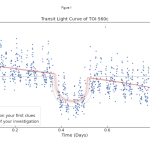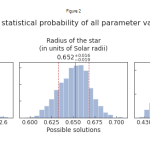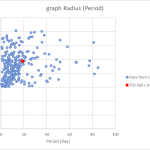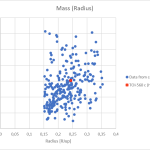
Project Gallery 2023
Secondary students from across Europe became exoplanet detectives with ESA and used Cheops satellite data to uncover the mysteries of two exoplanet targets: KELT-3b and TOI-560c.
Explore the projects below.
Abakus
Best Project Prize Winner
University of Nova Gorica Ajdovščina – Slovenia 16 years old, 17 years old 2 / 2
TOI-560c
TOI-560c project description:
As a part of the Hack an Exoplanet project, we have analyzed two exoplanets and taken a closer look at the exoplanet TOI-560c. Exoplanets are planets orbiting other stars outside our Solar System. Their properties (size, mass, orbit) are measured using data obtained from astronomical observations. We have analyzed data from the CHEOPS satellite (ESA), which has observed the passage of an exoplanet across its host star, during which it partly blocked the star’s light. Using the online tool allesfitter and our own analysis, we found that the planet belongs to the class of mini-Neptunes and that its properties do not differ significantly from the known population of mini-Neptunes. The planet has a rocky core. It orbits its star at a relatively low distance, and its surface temperature exceeds the limit for liquid water to exist. Life as we know it, therefore, cannot exist on TOI-560c.
TOI-560c Results and Analysis
We started our analysis by accessing the allesfitter web tool. The application provided observational data of the passage. The application also allowed us to fit a model to the data, giving us values for some of the exoplanet parameters and its orbit. First, we manually adjusted the planet’s radius, the star’s radius, and the time of the midpoint of the transit to guess the best-matching model to the light curve. The tool then used an algorithm to find the best model for the transit. Figure 1 shows the data, overplotted with the family of best models (red) and our initial guess (gray). Histograms of the most likely values for planet radius, star radius, and mid-transit time are shown in Figure 2, and the values, including uncertainties, are given in the table (Figure 3). The most probable values are 2.39 Earth radii, 0.65 Sun radii, and 0.44 days. The table also gave values for the planet’s orbital period (18.8 days) and the size of the orbital ellipse semi-axis (0.1242 au)–these had been measured by other means.
We also measured the values of some of the parameters differently. We calculated the ratio between the planet’s size and the star’s size via the dimming of the star during the transit. Knowing the size of the star (0.65 solar radii), we were able to calculate the radius of the planet (2.46 Earth radii). Using the known period and Kepler’s third law, we calculated the semi-major axis of the orbit (0.125 au). Knowing the size and mass of the planet (the mass was measured using the radial method, its value is about 9.7 Earth masses), we can calculate the planet’s average density (3.6 g cm-3).
We can also estimate the temperature of the planet. The equilibrium temperature of the planet was calculated by assuming that the star radiates light as a black body, the planet absorbs some of the light and reflects some of it, and that the planet radiates some of the energy. We calculated the temperature for two different rotational speeds of the planet around its axis – slow and fast. We have assumed that the temperature at the star’s surface is 4511 K [1]. For the reflectivity or albedo, we have adopted a value of 0.1 (an approximate estimate for a mini-Neptune). For a planet rotating slowly, we have thus obtained a temperature of 574 K, and for a planet rotating rapidly, 483 K. The latter value is similar to the value provided in the case file and in [1]. Our calculation is simplified because we have not considered the planet’s composition and atmosphere. If the atmosphere is denser, less energy will go back into space than if the atmosphere is thinner. We can see this when we look at Venus and compare its temperature and atmosphere with our own – Earth’s. We also looked at how far away a planet would have to be to have liquid water. Under the above assumptions, a planet must have at least five times its current distance from the star to have liquid water (and more likely it would have to be even farther away).
TOI-560c is probably a rocky planet. It is relatively close to the star, so its surface temperature is too high for liquid water. There is no other planet like it in our Solar System. It is four times closer to a star than Mercury is to the Sun. As we know, there are no mini-Neptunes in our Solar System, but they are often found around other stars.
Finally, we looked at how TOI-560c compares to other mini-Neptunes. We obtained a sample of mini-Neptunes [2], i.e., exoplanets with radii between 1.7 and 4 Earth radii and masses less than 20 Earth masses [3]. Figures 4 and 5 show the dependencies between period and radius and radius and mass for the sample. ToI-560c is highlighted in red. We found that TOI-560c is a typical Mini-Neptune with a radius that deviates from the average radius of Mini-Neptunes (2.5 Earth radii) by only 2%. Its period is also close to the average but higher than the median because most of the Mini-Neptunes found are closer to the star (probably due to observational bias). When comparing radius and mass, TOI-560c does not stand out either.
Our measurements could be improved. In particular, we have not accounted for the uncertainties. We also attach a case file of our analysis of the planet.
[1] http://exoplanet.eu/catalog/hd_73583_c/
[2] http://exoplanet.eu/catalog/
[3] https://arxiv.org/ftp/arxiv/papers/1405/1405.7695.pdf
TOI-560c Conclusions
After completing our calculations, we have concluded that the planet is very close to its star and, given its density, is most likely a rocky planet. It has a relatively high surface temperature, so we expect no liquid water on its surface and no life as we know it. By comparing TOI-560c to a sample of known mini-Neptunes, we have come to the conclusion that TOI-560c is a typical representative of mini-Neptunes, as its values for most of the parameters are very close to the catalog averages. TOI-560c is unlike any planet in our Solar System.
Supporting files:






